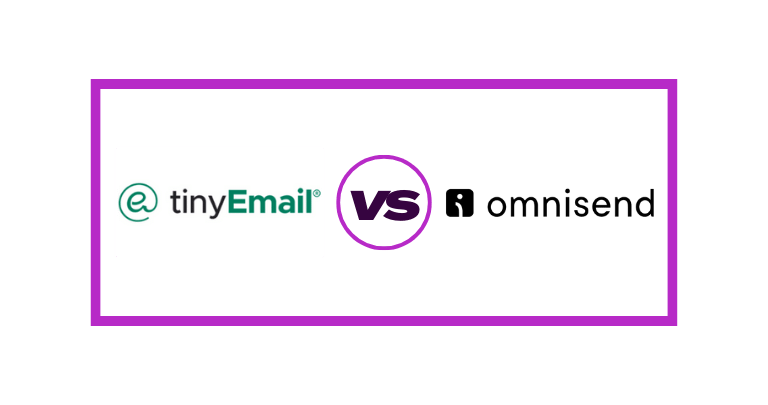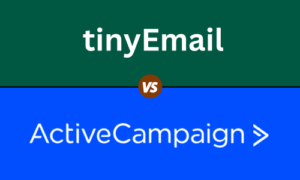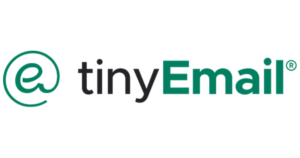Table of Contents
Introduction
In the vast email marketing arena, two titans clash: Omnisend and tinyEmail. Each platform, like a mighty warrior, offers formidable tools to forge captivating campaigns and conquer inboxes. But which champion reigns supreme for your specific quest? Fear not, intrepid marketer! We embark on a deep dive into their strengths and weaknesses, crafting a guide to illuminate the perfect Excalibur for your email marketing adventures. Buckle up, strategize, and prepare to wield the data, features, and insights that will propel your campaigns to legendary success!
Which Platform is Right For You
Choosing the right email marketing platform is crucial for your business, and understanding the target audience and market focus of each tool is key to making an informed decision. In the battle between Omnisend and tinyEmail, this aspect takes center stage. Let’s explore who each platform caters to and how they cater to them.
Omnisend:
Market Focus: E-commerce, specifically growing online stores
Target Audience:
- E-commerce businesses of all sizes, from startups to established brands
- Marketers focused on driving e-commerce sales and conversions
- Individuals seeking advanced personalization and automation
Strengths:
- Robust e-commerce integrations with platforms like Shopify and WooCommerce
- Powerful automation features for personalized product recommendations, abandoned cart recovery, and triggered workflows
- AI-powered tools for audience segmentation and dynamic content generation
- Advanced reporting and analytics to track e-commerce KPIs
tinyEmail:
Market Focus: General email marketing for various industries
Target Audience:
- Small businesses and individuals starting with email marketing
- Non-e-commerce businesses focused on basic email campaigns and lead generation
- Users seeking affordability and ease of use
Strengths:
- Simple and intuitive interface, perfect for beginners
- Affordable pricing plans with transparent tiered features
- Basic automation tools for welcome emails and triggered campaigns
- Reliable email deliverability and spam prevention measures
So, which platform is right for you?
Here’s a quick breakdown:
- Choose Omnisend if:
- You run an e-commerce store and want advanced tools to drive sales and conversions.
- You need personalization and automation features for customer journeys.
- You’re comfortable with a feature-rich platform and don’t mind investing in its capabilities.
- Choose tinyEmail if:
- You’re new to email marketing and want a user-friendly platform to get started quickly.
- You run a non-e-commerce business and need basic email campaigns for lead generation or communication.
- You’re on a tight budget and prioritize affordability.
Remember, both Omnisend and tinyEmail offer free trials. Testing their features and user interface firsthand can help you make the final decision and find the perfect fit for your target audience and marketing goals.
By understanding the focus and strengths of each platform, you can confidently choose the one that will power your email marketing success. Now go forth and conquer those inboxes!
Ease of Use and Interface
When it comes to email marketing, choosing a platform shouldn’t feel like deciphering ancient hieroglyphics. Both Omnisend and tinyEmail strive for user-friendliness, but catering to different levels of experience. Buckle up as we explore their interfaces and see which one might feel like home for you.
Omnisend:
A Feature-Packed Playground: Omnisend’s interface boasts a modern, slick design with numerous features readily accessible. Think of it as a well-equipped kitchen – everything’s there, but mastering the tools takes some practice.
- Pros: The drag-and-drop email builder empowers even non-designers to create stunning visuals. Numerous pre-built templates offer a solid foundation, and customization options abound.
- Cons: With a wealth of features comes a learning curve. Menus and options can feel overwhelming for absolute beginners.
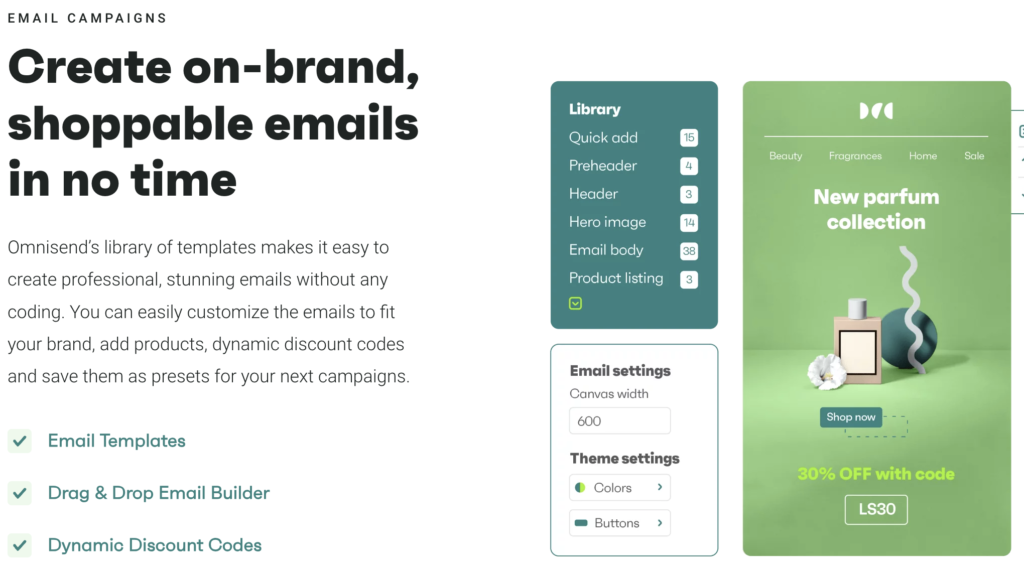
tinyEmail:
Simplicity Reigns Supreme: tinyEmail champions a minimalist approach. Its interface is clean, straightforward, and feels instantly familiar. Think of it as a cozy coffee shop – everything you need is within reach, and the atmosphere is calm and inviting.
- Pros: The intuitive design makes starting a breeze. Even email marketing newbies can navigate campaigns and features with minimal effort. The learning curve is practically non-existent.
- Cons: Limited customization options and fewer pre-built templates might restrict design freedom for users seeking extensive visual control.
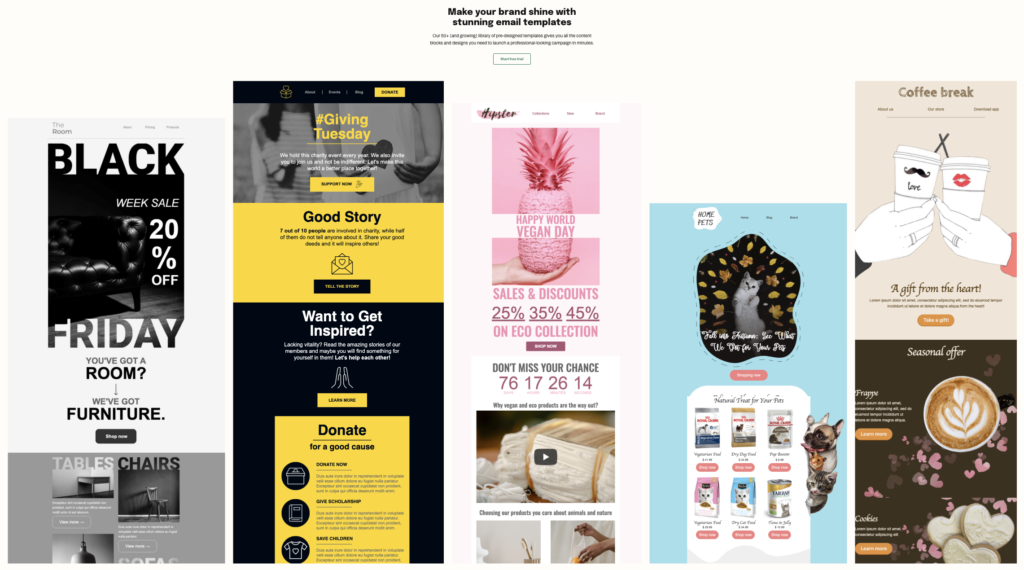
So, which path leads to ease-of-use?
- Choose Omnisend if:
- You’re comfortable exploring various features and learning new things.
- You value extensive customization and design flexibility.
- You don’t mind investing time in mastering a powerful platform.
- Choose tinyEmail if:
- You want to hit the ground running with minimal setup.
- You prioritize a simple and intuitive interface.
- You’re new to email marketing and want a platform that won’t overwhelm you.
Ultimately, the “ideal” interface is subjective. Consider your comfort level with technology, desired level of control, and learning preferences to make the best choice.
Let the ease-of-use battle commence! Conquer those inboxes with an interface that empowers you, not intimidates you.
Email Marketing Features
In the realm of email marketing, features are the mighty weapons that help you conquer inboxes and nurture leads. Both Omnisend and tinyEmail offer unique arsenals, designed for different campaigns and conquests. Let’s explore their strengths and see which platform equips you for email marketing dominance.
Omnisend: The Feature-Rich Fortress
Think of Omnisend as a well-stocked armory overflowing with advanced weaponry. Here’s a glimpse of its impressive arsenal:
- Email Creation & Design: Drag-and-drop builder, extensive pre-built templates, dynamic content insertion, AMP for interactive emails.
- List Management & Segmentation: Advanced segmentation tools, dynamic lists based on behavior and website activity, GDPR compliance features.
- Automation & Workflows: Powerful automation capabilities for triggered emails, abandoned cart recovery, personalized product recommendations, and customer journeys.
- Integrations & Plugins: Seamless integration with e-commerce platforms, CRM systems, and marketing automation tools for a unified strategy.
- Analytics & Reporting: In-depth reporting with open rates, click-through rates, conversion metrics, and custom reports for tailored insights.
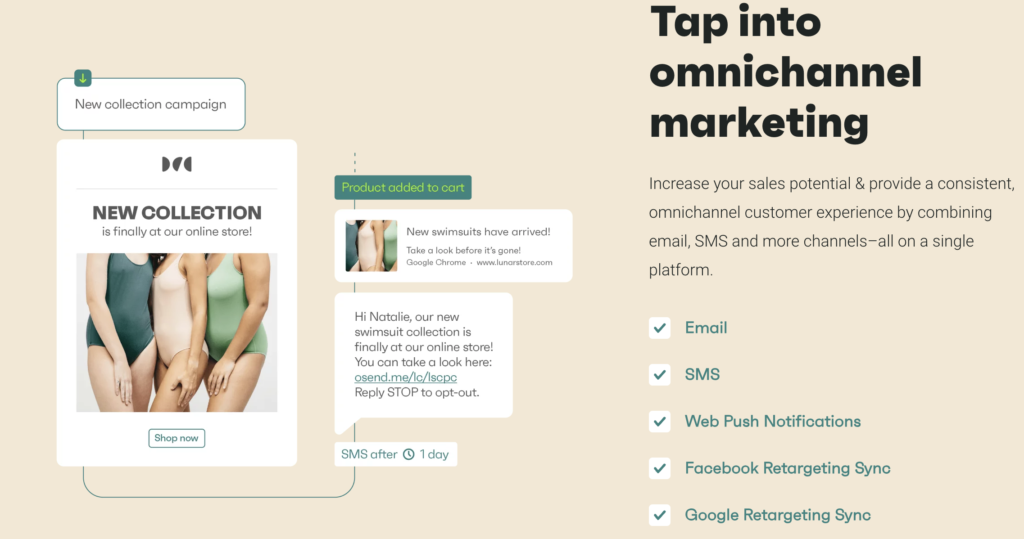
tinyEmail: The Streamlined Skirmish Line
Imagine tinyEmail as a lean, agile squad with efficient tools for quick strikes. Its features pack a punch, but prioritize simplicity and focus:
- Email Creation & Design: Drag-and-drop builder, decent selection of pre-built templates, basic image and text editing functionalities.
- List Management & Segmentation: Create and manage subscriber lists, basic segmentation options based on demographics and email activity.
- Automation & Workflows: Set up welcome email series, basic triggered campaigns, and automated follow-up sequences.
- Integrations & Plugins: Limited integrations with popular email marketing tools and CRMs.
- Analytics & Reporting: Track open rates, click-through rates, and basic campaign performance metrics.
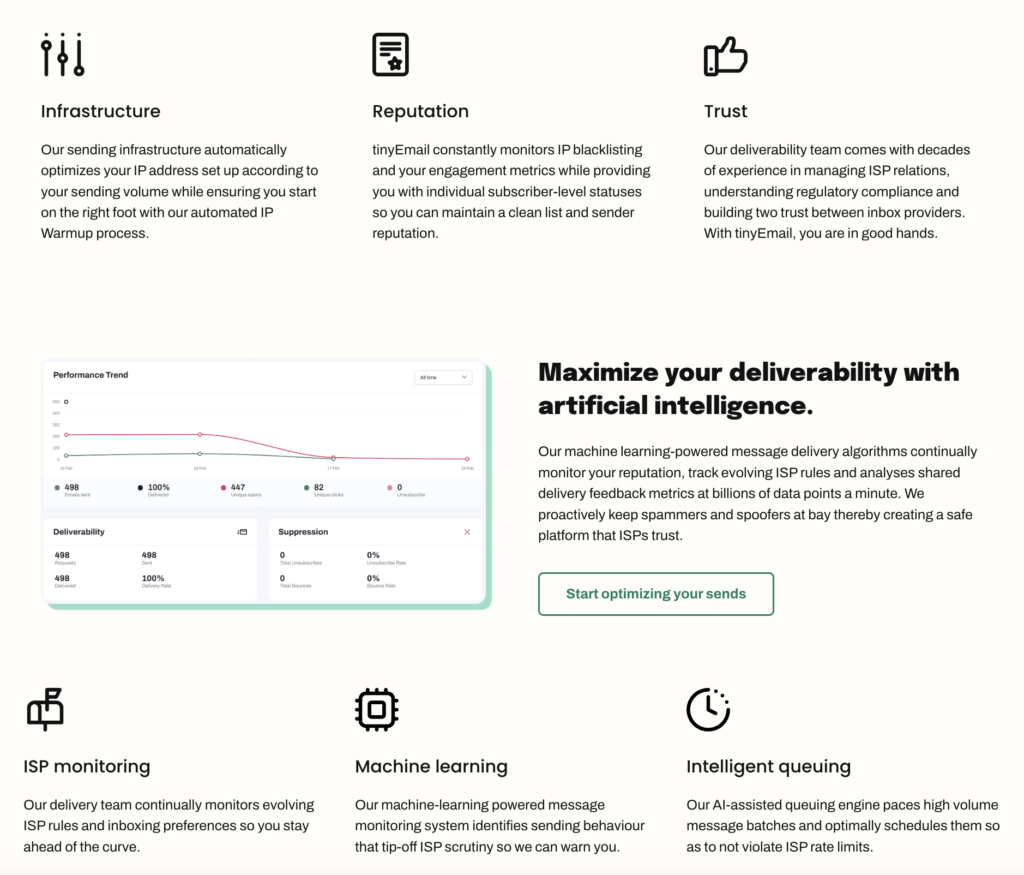
So, which arsenal suits your email marketing ambitions?
- Choose Omnisend if:
- You crave advanced automation and personalization features.
- You need in-depth analytics and custom reporting for data-driven decisions.
- You plan intricate customer journeys and multi-channel marketing campaigns.
- Choose tinyEmail if:
- You prioritize ease of use and a quick campaign setup.
- You require basic automation features for essential email sequences.
- You have a smaller budget and don’t need extensive reporting or integrations.
Automation and Workflow Management
In the symphony of email marketing, automation and workflows are the conductors, guiding subscribers on personalized journeys. Both Omnisend and tinyEmail offer tools to orchestrate success, but cater to different compositions. Let’s explore their strengths and see which platform harmonizes with your marketing goals.
Omnisend: The Maestro of Multi-Stage Automation
Think of Omnisend’s automation as a grand opera, brimming with complex movements and intricate interplay. Here’s what makes it sing:
- Powerful Visual Builder: Drag-and-drop functionality allows you to design multi-stage workflows with triggers, conditions, and targeted email actions.
- Advanced Segmentation: Craft personalized journeys based on customer behavior, purchase history, and website activity for laser-focused campaigns.
- Triggered Emails: Respond to specific events like abandoned carts, birthdays, or product interactions with automated emails that nurture leads and drive conversions.
- Dynamic Content and Product Recommendations: Insert personalized product suggestions and content based on individual preferences for a truly customized experience.
- A/B Testing and Optimization: Refine your automation with built-in A/B testing and data-driven insights to maximize campaign performance.
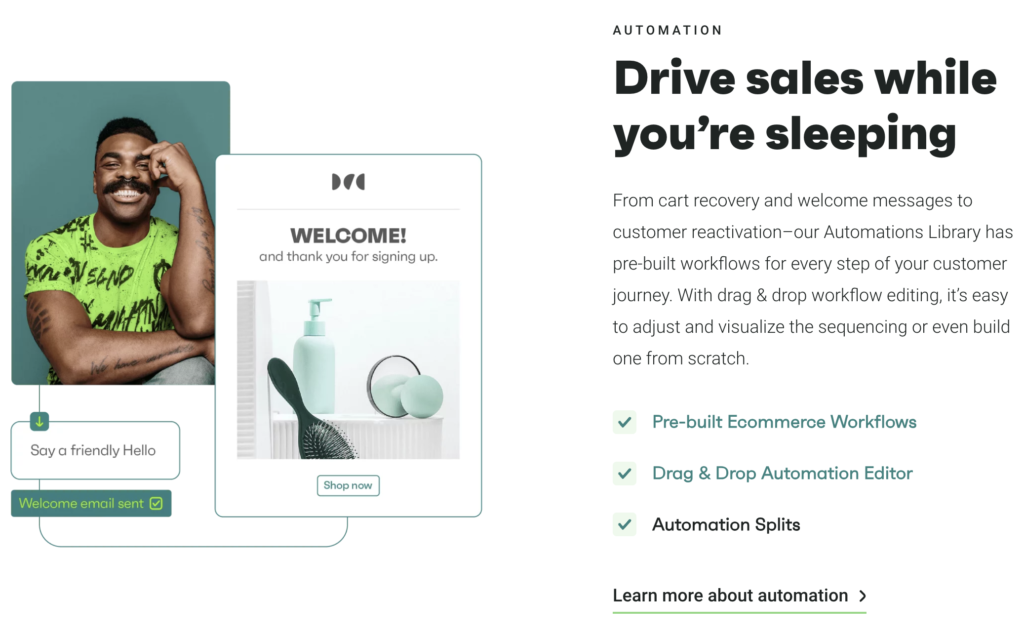
tinyEmail: The Chamber Soloist of Basic Workflows
Imagine tinyEmail’s automation as a charming folk song, simple yet effective. Here’s its focus:
- Basic Automation Sequences: Set up welcome email series, abandoned cart flows, and basic triggered campaigns for essential customer touchpoints.
- Limited Segmentation: Segment subscribers based on demographics and email activity for targeted messaging.
- Pre-Built Automation Templates: Get started quickly with ready-made automation templates for common scenarios.
- Visual Flow Builder: A simplified drag-and-drop interface makes crafting basic workflows straightforward for beginners.
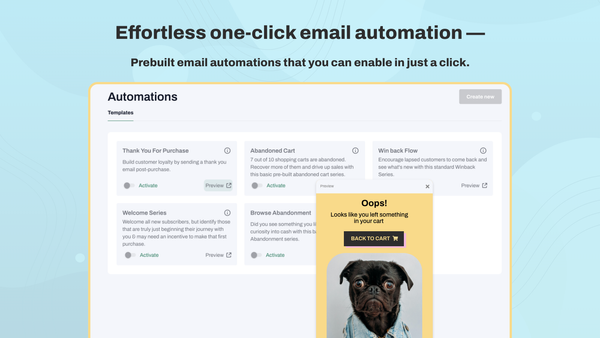
So, which conductor will lead your email marketing performance?
- Choose Omnisend if:
- You desire complex multi-stage automation with advanced segmentation and personalization.
- You seek data-driven optimization and A/B testing to refine your workflows.
- You manage intricate customer journeys across multiple touchpoints.
- Choose tinyEmail if:
- You need basic automation for core email sequences like welcome series and abandoned cart recovery.
- You prefer a simple and user-friendly interface for quick setup and campaign launches.
- You’re new to automation and want to start with pre-built templates for guidance.
Integration Capabilities
In the intricate web of marketing success, integrations act as the crucial bridges, connecting your email platform with other tools and data sources. Both Omnisend and tinyEmail offer pathways across this digital landscape, but cater to different destinations. Let’s explore their strengths and see which platform builds the bridges you need to conquer your marketing goals.
Omnisend: The Master Connector
Think of Omnisend as the Golden Gate Bridge of integrations, a robust structure connecting you to a vast landscape of possibilities. Here’s what makes it stand tall:
- Extensive Integrations: Seamslessly connect with popular e-commerce platforms like Shopify, WooCommerce, and BigCommerce for automated product recommendations, abandoned cart recovery, and personalized campaigns.
- CRM and Marketing Automation Tools: Integrate with CRMs like Salesforce and HubSpot to centralize customer data and personalize communication across channels.
- Payment Gateways: Connect with payment gateways like Stripe and PayPal to track purchase data and trigger relevant email sequences based on transactions.
- Analytics and Reporting Tools: Integrate with Google Analytics and Facebook Ads for a holistic view of campaign performance and deeper insights.
- API Access: Build custom integrations with specialized apps and tools for even greater flexibility.
tinyEmail: The Charming Ferry across Essential Channels
Imagine tinyEmail’s integrations as a quaint ferryboat, offering efficient passage to key destinations. Here’s what it navigates well:
- Basic E-commerce Integrations: Connect with popular platforms like Shopify and WooCommerce for basic product data integration and email personalization.
- Email Marketing and CRM Tools: Integrate with MailChimp and ActiveCampaign for basic data syncing and cross-channel campaign management.
- Limited API Access: Offers basic API features for developers to build simple custom integrations.
So, which bridge leads you to marketing utopia?
- Choose Omnisend if:
- You rely on advanced e-commerce features and data exchange with platforms like Shopify or WooCommerce.
- You want to connect with various marketing automation tools and CRMs for a unified strategy.
- You require custom integrations through API access for specific needs.
- Choose tinyEmail if:
- You need basic product data integration and email personalization for your e-commerce store.
- You already use MailChimp or ActiveCampaign and want basic data syncing with tinyEmail.
- You prioritize cost-effectiveness and a simple setup for essential integrations.
Customization and Personalization
In the email marketing world, the power lies in making messages feel like personal whispers, not mass broadcasts. Customization and personalization are the magic wands that transform impersonal emails into engaging conversations. Let’s explore how Omnisend and tinyEmail wield these wands and see which platform helps you cast a spellbinding impression on your subscribers.
Omnisend: The Grand Illusionist of Personalization
Think of Omnisend as Penn & Teller of email marketing, pulling off sophisticated audience illusions that feel tailor-made. Here’s their impressive showmanship:
tinyEmail: The Charming Storyteller of Basic Customization
Imagine tinyEmail as the captivating bard of email marketing, weaving basic but engaging narratives for your audience. Here’s their storytelling charm:
- Merge Tags and Personalization Variables: Insert subscriber names, locations, and other basic data points into emails for a touch of personalization.
- Segmentation: Segment your audience by demographics and basic email activity for targeted messaging.
- Pre-Built Personalized Email Templates: Get started quickly with ready-made templates that offer some level of audience customization.
So, which wand casts the most personalized spell?
- Choose Omnisend if:
- You crave deep personalization with dynamic content, AI-powered recommendations, and complex segmentation strategies.
- You want to leverage data and A/B testing to optimize your personalization efforts for higher engagement.
- You manage diverse audience segments and need intricate customer journey customization.
- Choose tinyEmail if:
- You prioritize ease of use and want basic personalization features for a quick setup.
- You have a smaller audience and require simple segmentation and merge tag personalization.
- You’re on a budget and prioritize affordability over advanced personalization capabilities.
Analytics and Reporting
In the realm of email marketing, data isn’t just numbers on a page; it’s the whispered language of your audience, revealing what resonates and what falls flat. Analytics and reporting are the translators, transforming raw data into actionable insights that guide your campaign success. Let’s explore how Omnisend and tinyEmail decode your email performance and see which platform whispers the most valuable secrets.
Omnisend: The Oracle of Granular Insights
Think of Omnisend’s analytics as a crystal ball, offering a nuanced and detailed view of your email campaigns. Here’s a glimpse of the future it reveals:
- In-Depth Campaign Reporting: Track open rates, click-through rates, conversion rates, and revenue generated for each campaign, with custom breakdowns by device, location, and subscriber segment.
- Advanced Attribution Modeling: Understand the true impact of your entire marketing ecosystem, attributing conversions to touchpoints beyond just the last click.
- A/B Testing and Optimization: Test different subject lines, email layouts, and content variations to identify the elements that drive the best results.
- Custom Reports and Data Exports: Build custom reports based on specific metrics and export data for further analysis in your preferred tools.
- AI-Powered Insights: Leverage AI to uncover hidden trends and patterns in your data, informing targeted campaign adjustments and future strategies.
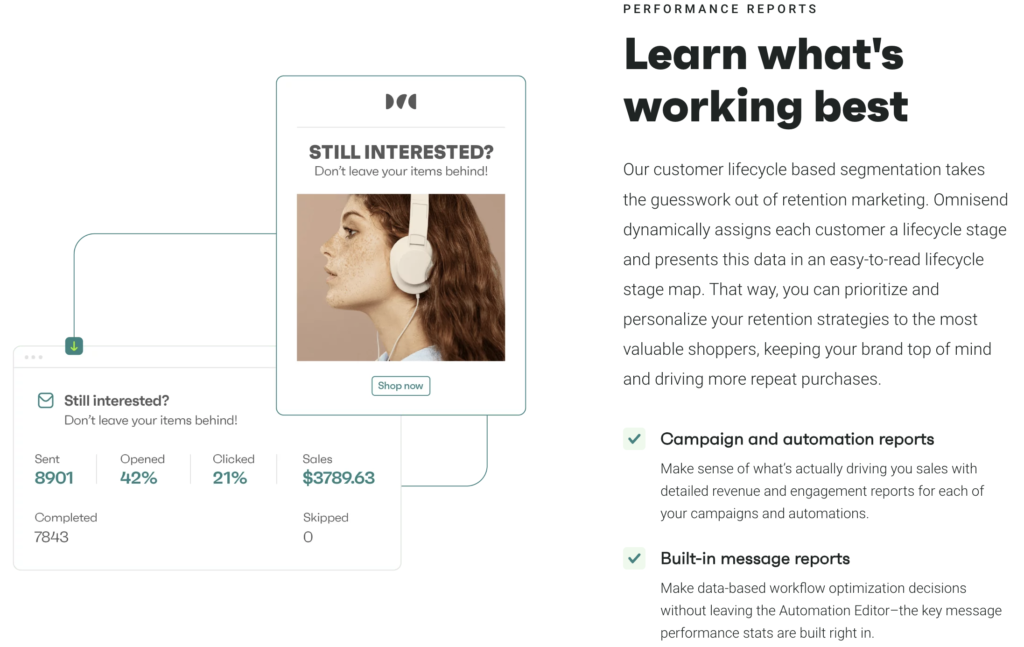
tinyEmail: The Fortune Teller of Essential Metrics
Imagine tinyEmail’s analytics as a friendly tarot deck, offering simple but insightful guidance. Here’s what it reveals:
- Basic Campaign Performance Tracking: Monitor open rates, click-through rates, and unsubscribes for each campaign, offering a general understanding of audience engagement.
- Limited Segmentation Reporting: Analyze campaign performance for basic subscriber segments like location and demographics.
- Pre-Built Reports and Dashboards: Get started quickly with ready-made reports summarizing key campaign metrics.
- Data Exports: Export basic data for further analysis in other tools.
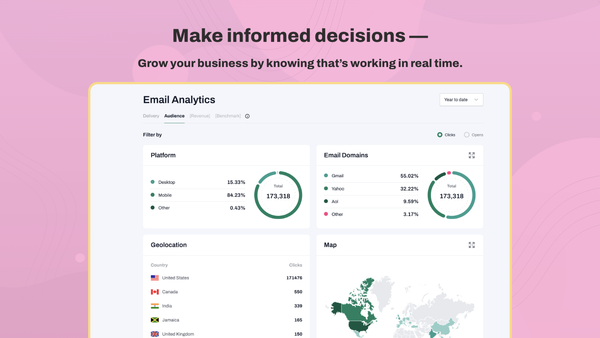
So, which oracle whispers the most valuable wisdom?
- Choose Omnisend if:
- You crave deep dives into your data, seeking detailed insights and granular performance breakdowns.
- You want to leverage advanced attribution modeling and AI-powered analysis for strategic campaign optimization.
- You manage complex multi-channel marketing campaigns and need comprehensive data to connect the dots.
- Choose tinyEmail if:
- You prioritize a simple and easy-to-understand overview of your campaign performance.
- You’re comfortable with basic metrics and pre-built reports for quick insights.
- You’re on a budget and don’t require in-depth data analysis or advanced reporting features.
Pricing
Omnisend: Power Meets Premium
Think of Omnisend’s pricing as a scaling war chariot, offering flexibility alongside advanced features. Here’s the breakdown:
- Tiered Pricing: Plans starting at $16 per month for 500 subscribers, with higher tiers unlocking advanced features like automation, AI insights, and unlimited emails.
- Pay-as-you-go Option: Pay only for the subscribers you have, offering flexibility for fluctuating audience sizes.
- Free Trial: 14-day trial to test drive the platform and its features before committing.
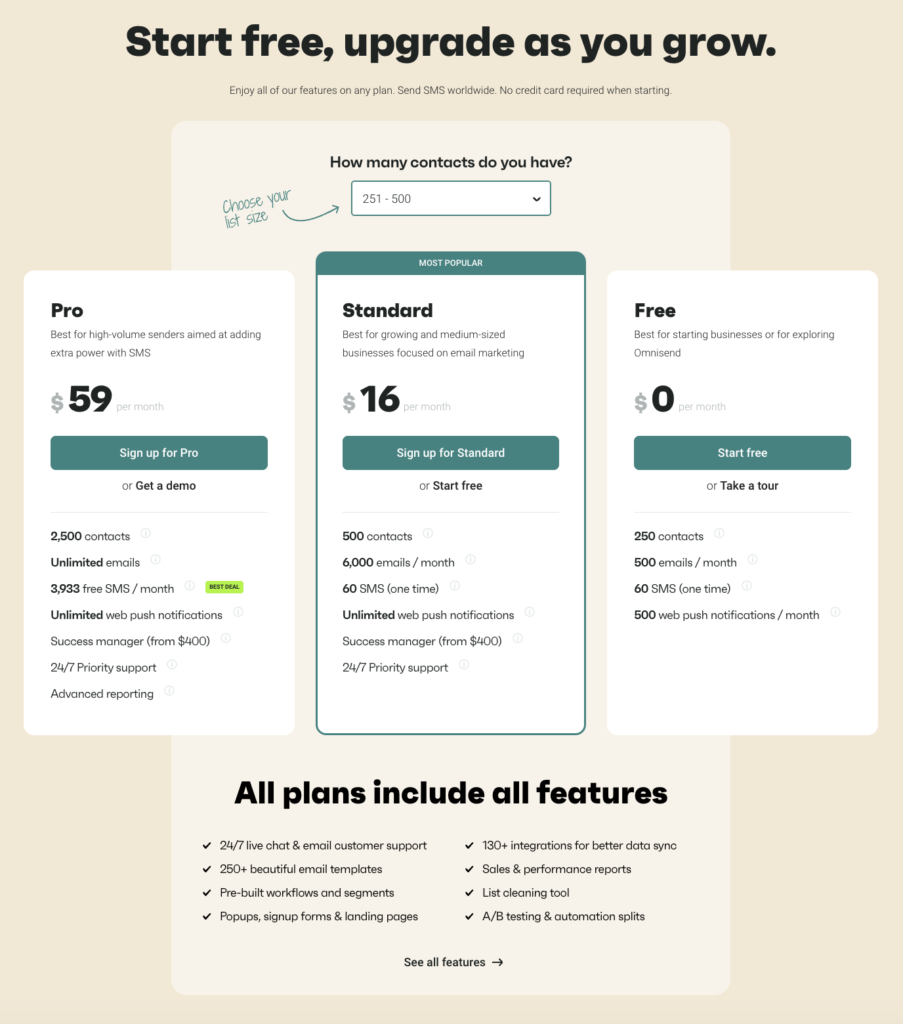
tinyEmail: Simplicity at a Budget-Friendly Price
Imagine tinyEmail’s pricing as a nimble scout, offering basic essentials at a pocket-friendly cost. Here’s the lean lineup:
- Flat-Rate Pricing: Plans starting at $15 per month for unlimited subscribers, with higher tiers unlocking basic automation and integrations.
- No Pay-as-you-go: Pricing based on features, not subscriber count, making it predictable for steady audience sizes.
- Free Plan: Forever-free plan with limited features for testing the waters.
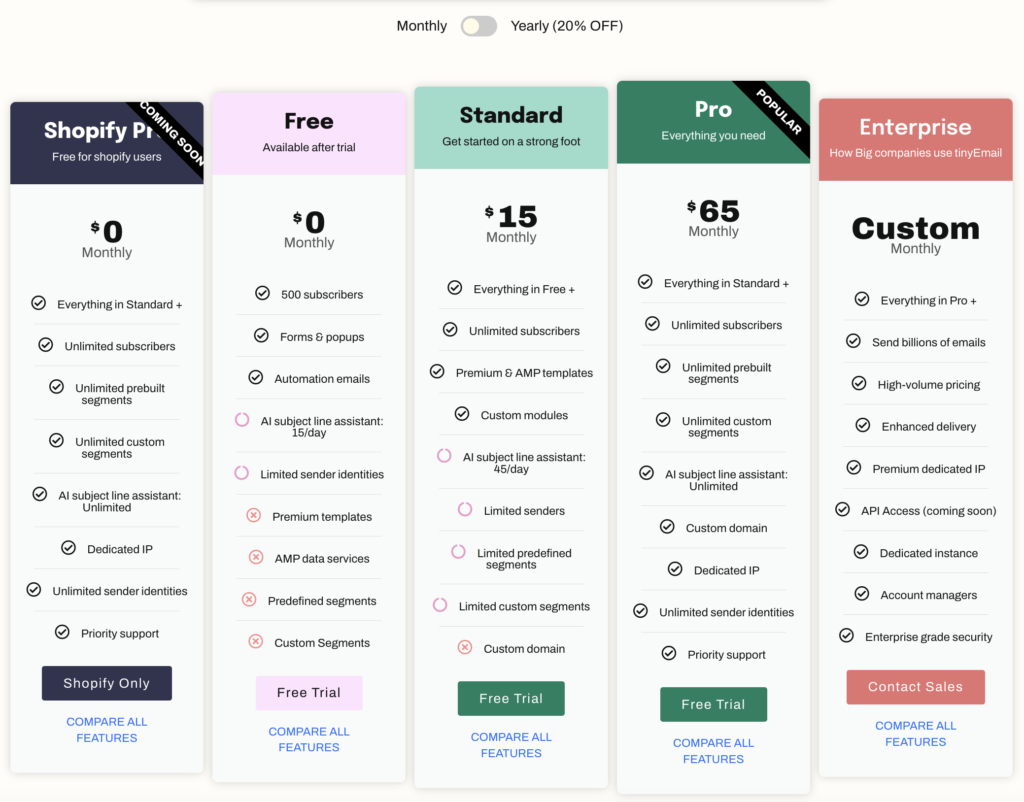
So, which war chest fuels your email marketing victory?
- Choose Omnisend if:
- You seek advanced features like automation, AI insights, and comprehensive reporting.
- You have a growing audience and anticipate scaling up your email marketing efforts.
- You value flexibility and prefer pay-as-you-go options.
- Choose tinyEmail if:
- You prioritize affordability and ease of use for basic email campaigns.
- You have a consistent audience size and don’t require advanced features.
- You want a predictable fee without worrying about subscriber fluctuations.
Customer Support
Omnisend: A Dedicated Command Center for Assistance
Think of Omnisend’s support as a well-equipped war room, offering diverse resources and personalized assistance for every campaign need. Here’s how they stand guard:
tinyEmail: A Friendly Scout Offering Guidance
Imagine tinyEmail’s support as a trusty scout, offering basic navigation and assistance for your email marketing journey. Here’s how they guide you:
- Email and Help Center: Get assistance through email and browse through their help center for FAQs and troubleshooting guides.
- Community Forum: Connect with other users and share experiences in a supportive online community.
- Self-Paced Video Tutorials: Learn basic platform features and functionalities through video tutorials.
So, which lifeline secures your email marketing success?
- Choose Omnisend if:
- You require dedicated and personalized support through multiple channels.
- You need advanced guidance and strategic consultations for complex campaigns.
- You value extensive resources and self-paced learning materials.
- Choose tinyEmail if:
- You prefer basic email support and community-driven assistance.
- You have a smaller audience and simpler email marketing needs.
- You prioritize affordability and cost-effective support options.
Remember, the ideal lifeline depends on your support preferences, budget, and complexity of email marketing endeavors.
Pros and Cons
Choosing the right email marketing platform is like picking the perfect weapon for your campaign conquest. Both Omnisend and tinyEmail offer powerful tools, but understanding their strengths and weaknesses will help you forge the optimal victory. Let’s unsheathe their pros and cons and see which one fits your strategic armory.
Omnisend:
Pros:
- Feature-Packed Arsenal: Advanced automation, AI-powered personalization, comprehensive reporting, and seamless integrations equip you for complex campaigns.
- Customization and Personalization Mastery: Dynamic content, advanced segmentation, and A/B testing let you tailor messages for laser-focused impact.
- Data-Driven Optimization: In-depth reporting and AI insights empower you to refine strategies and maximize campaign performance.
- Scalability and Futureproof Potential: Flexible pricing and robust features cater to growing audiences and evolving marketing needs.
Cons:
- Learning Curve: The feature-rich interface can be daunting for beginners, requiring some investment in learning.
- Higher Price Point: Advanced features come at a cost, making it potentially less budget-friendly for smaller businesses.
tinyEmail:
Pros:
- Simple and User-Friendly: Intuitive interface makes it easy for anyone to create and launch email campaigns quickly.
- Affordable Option: Basic features and flat-rate pricing are ideal for smaller businesses or budget-conscious marketers.
- Solid Essentials: Pre-built templates, basic automation, and essential integrations cover core email marketing needs.
- Community and Self-Sufficiency: Active community forum and helpful video tutorials offer self-paced learning and support.
Cons:
- Limited Features: Lacks advanced automation, personalization, and data analysis capabilities for complex campaigns.
- Scalability Concerns: Flat-rate pricing might not be cost-effective for larger audiences or expanding needs.
- Integration Restrictions: Limited integrations with essential e-commerce platforms and marketing tools.
So, which champion claims your email marketing allegiance?
- Choose Omnisend if:
- You seek advanced features and data-driven optimization for intricate campaigns.
- You have a growing audience and anticipate scaling up your email marketing efforts.
- You value powerful integrations and AI-powered insights for targeted personalization.
- Choose tinyEmail if:
- You prioritize ease of use and a quick setup for basic email campaigns.
- You have a smaller audience and operate on a tighter budget.
- You’re comfortable with pre-built templates and community-driven support.
Remember, the ideal champion depends on your campaign goals, budget, and desired level of sophistication.
Conclusion
Navigating the email marketing landscape can feel like venturing into a mythical realm brimming with powerful tools and potential peril. But fear not, valiant marketer! You’ve just embarked on a heroic quest through the strengths and weaknesses of Omnisend and tinyEmail, two worthy contenders for your email marketing Excalibur.
Remember, the ideal platform is not a preordained destiny, but a choice forged in the fires of your own needs and ambitions. Choose Omnisend if you seek advanced features and data-driven insights to conquer complex campaigns with laser-focused precision. Embrace tinyEmail if you value ease of use and affordability, wielding its streamlined arsenal to launch effective campaigns while navigating budget constraints.
Ultimately, the victor in this battle is not the platform itself, but you, the empowered marketer who wields its tools with strategic purpose. So, go forth, champion! Craft captivating campaigns, forge meaningful connections with your audience, and let your email marketing success resonate far and wide. May your inbox conquests be legendary!

